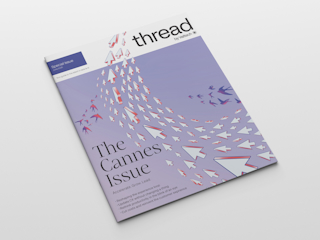Thread
The trust factor
Why AI is making brand identity more important than ever in B2B

For years, B2B marketing has prioritized what’s easy to measure: clicks, conversions, cost per lead. It made marketing look efficient — but also overly transactional. Brand was often treated as a nice-to-have, the “creative” layer you added once the performance engine was humming.
That mindset is outdated. B2B buyers are already 70% through their purchasing process before your sales team ever gets involved. Buyers are reading analyst reports, scanning peer reviews and watching product videos all before they reach out. In more than 80% of cases, it’s the buyer who makes the first move.
That means your brand needs to work harder, earlier — shaping the narrative long before your team gets a chance to pitch. But you don’t just need to think about buyers when building your brand. You need to consider algorithms, too.
When AI joins the buyer group
AI isn’t just shaping how buyers find vendors; it’s influencing how they evaluate and select them.
GenAI tools now perform the work of a junior team member: scanning content, comparing solutions and summarizing brand narratives before a sales conversation ever happens. For younger buyers, this shift is already here: 48% of Gen Z and millennial B2B buyers say GenAI is their preferred first point of contact.
In an AI-first world, the most effective capital-P Performance strategy is built on a brand that machines can interpret, buyers can trust and both are confident recommending. Your brand is a strategic signal both to buyers and the systems advising them. It influences whether a company is recognized, represented accurately and included in the conversation at all.
One company that’s especially well positioned for the AI era is Gartner. Their research is widely cited. Their name is synonymous with credibility, and their language is consistent across formats — from analyst reports to earnings calls to how it’s referenced in third-party content. When AI summarizes vendor landscapes or builds category shortlists, Gartner shows up because they are embedded in the channels and conversations buyers already trust.
Valtech research backs this up. Trustworthiness consistently ranks as the No. 1 factor driving repeat purchases in B2B. That trust is no longer built through a handshake, however. It starts upstream, with how your brand shows up before the first touch.

If AI doesn’t recognize you, do you even exist?
B2B buyers have gotten better at research, and AI has made them even more efficient. The search journey now mirrors the B2B buying cycle. It often starts broad: “best ABM tools.” Then it narrows: “6Sense vs. DemandBase.” By the time someone lands on your site, they’re not browsing. They’re validating.
Throughout this journey, AI prioritizes authoritative, high-trust sources — brands with clear, consistent narratives that show up across channels. It’s no longer enough to produce good content. That content has to be distributed widely and aligned with a coherent identity, one that’s easy for both people and machines to understand.
AI also depends on access. If your most valuable content is buried behind forms or paywalls, it might not be surfaced at all. Brands must ensure their best thinking is machine-readable, indexable and unambiguous.
Put it all together and brands move from demanding attention to building trust. Valuable, consistent and accessible content helps brands appear throughout the buyer’s journey, from ungated research to analyst reports to LinkedIn discussions. By the time buyers need a solution, they are already top of mind.
Multimodal branding: Be recognizable everywhere, instantly
AI doesn’t consume content like humans do. It processes everything — language, visuals, voice, video — all at once. It looks for patterns. That makes brand consistency not just a creative goal, but a technical necessity.
Multimodal branding is a modern spin on a timeless principle: reinforce identity through distinct, repeatable cues.
Take Adobe. Whether you're watching a product demo, attending a Summit keynote or interacting with generative features in Photoshop, it all reinforces the same brand voice: premium, creative, trustworthy.
Their Firefly and Sensei platforms don’t just carry consistent names. They show up with unified language, visuals and messaging. That coherence makes them easy to interpret across formats, and easy to trust at scale.
Brand as the last moat in an AI world
AI can amplify your message, but it can’t define your purpose. It can distribute your voice, but it can’t give it meaning.
Purpose remains the foundation of a strong brand. Companies that stay true to it will cut through the noise, building trust and credibility with both people and machines.
The real advantage isn’t visibility. It’s being sought out.
Recognition will matter more than reach. Trust more than clicks. And the brands that prioritize connection over short-term wins will be the ones that thrive.
Brand isn’t in opposition to performance. It’s what makes sustainable performance possible.




